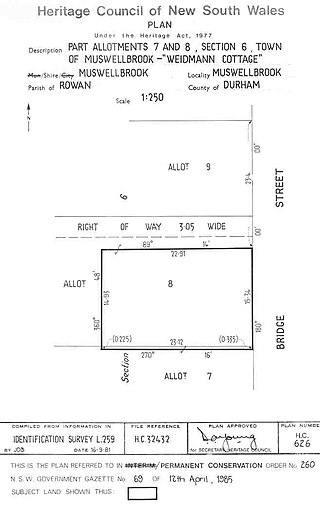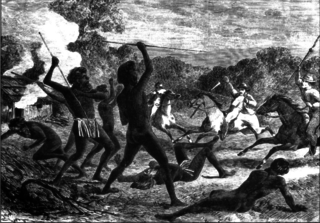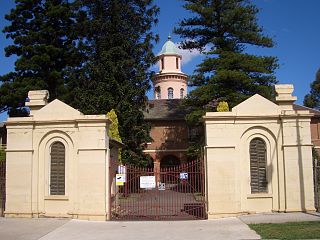
The Waterloo Creek massacre refers to a series of violent clashes between mounted settlers, civilians and Indigenous Gamilaraay people, which occurred southwest of Moree, New South Wales, Australia, during December 1837 and January 1838.

The Myall Creek massacre was the killing of at least 28 unarmed Aboriginal people in the Colony of New South Wales by eight colonists on 10 June 1838 at the Myall Creek in the north of the colony. Seven perpetrators were convicted of murder and hanged.

Experiment Farm Cottage is a heritage-listed former farm and residence and now house museum at 9 Ruse Street, Harris Park, City of Parramatta, Sydney, Australia. It is one of Australia's oldest standing residences, being built in c. 1834. It is located at the site of Experiment Farm, Australia's first European farmstead, which was itself created by Australia's first land grant. It was added to the New South Wales State Heritage Register on 2 April 1999.

Henry Dangar (1796–1861) was a surveyor and explorer of Australia in the early period of British colonisation. Despite an upheld challenge to some of his early land claims, he received huge land grants.

The Old Government Cottages Group consists of two heritage-listed houses at 16 Stanley Street and 1 George Street, Bathurst, Bathurst Region, New South Wales, Australia. The group was built from 1837 to 1860. The buildings are also known as 'Old Government House', Macquarie House, Miss Falloon's cottage and John Ford's house. The property is owned by Bathurst Regional Council. It was added to the New South Wales State Heritage Register on 21 February 2003.

The Bungarribee Homestead Site is a heritage-listed archaeological site at the location of the former Bungarribee Homestead. The site is located at Doonside Road, Doonside, New South Wales, a suburb of Sydney, Australia. It was added to the New South Wales State Heritage Register on 8 December 2000.

Loxton House is a heritage-listed former residence and now restaurant located at 142–144 Bridge Street, Muswellbrook in the Muswellbrook Shire local government area of New South Wales, Australia. It was built in 1838 and was added to the New South Wales State Heritage Register on 2 April 1999.

Weidmann Cottage is a heritage-listed former retail building, residence and town house and now unused building located at 132 Bridge Street, Muswellbrook in the Muswellbrook Shire local government area of New South Wales, Australia. It was built from 1840 to 1845. The property is owned by Muswellbrook Shire Council and was added to the New South Wales State Heritage Register on 2 April 1999.

Myall Creek Massacre and Memorial Site is the heritage-listed site of and memorial for the victims of the Myall Creek massacre at Bingara Delungra Road, Myall Creek, Gwydir Shire, New South Wales, Australia. The memorial, which was unveiled in 2000, was added to the Australian National Heritage List on 7 June 2008 and the New South Wales State Heritage Register on 12 November 2010.

Old Port Macquarie Courthouse is a heritage-listed former courthouse and now justice museum at Clarence Street (cnr), Port Macquarie, Port Macquarie-Hastings Council, New South Wales, Australia. It was designed by James Barnet and built in 1869 by Butler and Bourne. It was added to the New South Wales State Heritage Register on 2 April 1999.

Englefield is a heritage-listed former inn and now residence at 49 Newcastle Street, East Maitland, City of Maitland, New South Wales, Australia. It was built in 1837. It operated as the Black Horse Inn from 1845 to 1878. It was added to the New South Wales State Heritage Register on 30 April 2008.

Old Liverpool Hospital is a heritage-listed former hospital and now technical college at College Street, Liverpool, City of Liverpool, New South Wales, Australia. It was designed by Francis Greenway, Edmund Blacket and Walter Liberty Vernon and was built from 1822 to 1958, originally with the use of convict labour. Variously known as the Colonial Medical Service Hospital, Benevolent Asylum, Government Asylum and Liverpool State Hospital and Asylum, it is now the Liverpool campus of TAFE NSW. It was added to the New South Wales State Heritage Register on 11 December 2009.

Jarvisfield is a heritage-listed former pastoral property and now golf course at Old Hume Highway, Picton, Wollondilly Shire, New South Wales, Australia. It was designed by William Weaver, architect-engineer, and built from 1815 to 1864. It is also known as Wilton. The property is owned by the Wollondilly Shire Council. It was added to the New South Wales State Heritage Register on 2 April 1999.

Government Cottage Archaeological Site is the heritage-listed site of a cottage which served alternately as the base for the Colony of New South Wales' commandant of the Hawkesbury district, house of the district's magistrate and an "informal official residence" for the Governor of New South Wales when in the district. It is located at 41 George Street, Windsor, City of Hawkesbury, New South Wales, Australia. The original house was built from 1796 to 1815 and demolished c. 1920-21. It was also known as Commandant's House and Government House. It was added to the New South Wales State Heritage Register on 4 February 2011.

Bowman House is a heritage-listed former residence and now Hawkesbury Area Office of the National Parks and Wildlife Service at 368-370 Windsor Street, Richmond, New South Wales, an outer suburb of Sydney, Australia. It was built from 1817 to 1820 by James Blackman. It is also known as Bowman's Cottage. It was added to the New South Wales State Heritage Register on 2 April 1999.
Criminal activity in New South Wales, Australia is combated by the New South Wales Police Force and the New South Wales court system, while statistics about crime are managed by the Bureau of Crime Statistics and Research. Modern Australian states and cities, including New South Wales, have some of the lowest crime rates recorded globally with Australia ranked the 13th safest nation and Sydney ranked the 5th safest city globally. As of September 2018 the City of Blacktown (495.1) and City of Penrith (475.7) had the highest rates of violent crime per 100,000 in Sydney. Rural areas have comparatively high crime rates per 100,000 with rural shires such as Walgett Shire (1350.3) and Moree Plains Shire (1236.2) having some of the highest violent crime rates in the state. The overall NSW crime rate has been in steady decline for many years.
Myall Creek is a rural locality split between the local government areas of Inverell Shire and the Gwydir Shire in New South Wales, Australia. In the 2021 census, Myall Creek had a population of 27.

Edward Denny Day was an Irish-Australian police magistrate famous for arresting the perpetrators of the Myall Creek Massacre and capturing the bushranger Edward Davis.
John Henry Fleming was an Australian-born squatter and stockman, who is best known as being the ringleader of the 1838 Myall Creek massacre which resulted in the murder of at least twenty-eight unarmed members of the Wirraayaraay people, Indigenous Australians who spoke a Gamilaraay language.



















